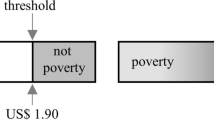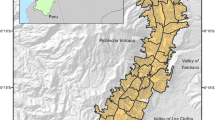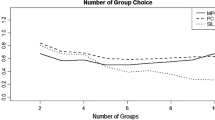Abstract
When comparing accessibility, the interpretation of results is complex because of lack of standard or universal norm. This uncertainty issue of the distinction from the lack of standard can be solved using the multi-level approach of fuzzy set: universal, relative, and absolute index. Since a fuzzy set approach deals with the vagueness and indiscernibility of accessibility index, the proposed approach suggests a better solution to classify the index than a crisp set or even a single-level fuzzy set approach. In this study, we evaluate job accessibility of locations in the Columbus MSA in Ohio, USA for 18 worker groups. The uncertain distinction between strong/weak, rich/poor, and higher/lower accessibility is improved by the multi-level approach. Moreover, this study attempts to enhance our understanding of spatial structure of job accessibility disaggregated by occupation type and gender.



Similar content being viewed by others
References
Aerts, J. C. J. H., Goodchild, M. F., & Heuvelink, G. B. M. (2003). Accounting for spatial uncertainty in optimization with spatial decision support systems. Transactions in GIS, 7(2), 211–230.
Ahlqvist, O. (2005). Using uncertain conceptual spaces to translate between land cover categories. International Journal of Geographical Information Science, 19(7), 831–857.
Alonso, W. A. (1964). Location and land use. Cambridge, MA: Harvard University Press.
Armstrong, R. B. (1979). National trends in office construction, employment, and headquarter location in U.S. metropolitan areas. In Spatial patterns of office growth and location. P. W. Daniels (Ed.). New York: Wiley.
Ban, H., & Ahlqvist, O. (2008). Representing and negotiating uncertain geospatial concepts—where are the exurban areas? Computers, Environment and Urban Systems. doi:10.1016/j.compenvurbsys.2008.10.001.
Benz, U. C., Hofmann, P., Willhauck, G., Lingenfelder, I., & Heynen, M. (2004). Multi-resolution, object-oriented fuzzy analysis of remote sensing data for GIS-ready information. Journal of Photogrammetry and Remote Sensing, 58(3–4), 239–258.
Buchanan, J. M. (1965). An economic theory of clubs. Economica, 32(125), 1–14.
Burrough, P. A., & McDonnell, R. A. (1998). Principles of geographical information systems. Oxford: Oxford University Press.
Burrough, P. A., van Gaans, P. F. M., & Hootsmans, R. (1997). Continuous classification in soil survey: Spatial correlation, confusion and boundaries. Geoderma, 77(2–4), 115–135.
Burrough, P. A., Wilson, J. P., van Gaans, P. F. M., & Hansen, A. J. (2001). Fuzzy k-means classification of topo-climatic data as an aid to forest mapping in the Greater Yellowstone Area, USA. Landscape Ecology, 16(6), 523–546.
Cervero, R. (1989a). America’s Suburban Centers: A study of the land-transportation link. Boston: Unwin-Hyman.
Cervero, R. (1989b). Jobs-housing balancing and regional mobility. Journal of the American Planning Association, 55(2), 136–150.
Cervero, R. (1996). Mixed land-uses and commuting: Evidence from the American housing survey. Transportation Research Part A—Policy and Practice, 30(5), 361–377.
Cervero, R., Rood, T., & Appleyard, B. (1999). Tracking accessibility: Employment and housing opportunities in the San Francisco Bay Area. Environment and Planning A, 31(7), 1259–1278.
Chen, Y. L., & Huang, T. C. K. (2008). A novel knowledge discovering model for mining fuzzy multi-level sequential patterns in sequence databases. Data and Knowledge Engineering, 66(3), 349–367.
Clark, D. (1982). Urban geography. Baltimore: Johns Hopkins University Press.
Clark, W. (2000). Monocentric to polycentric: New urban forms and old paradigm. In G. Bridge & S. Watson (Eds.), A companion to the city. Oxford, UK: Blackwell.
Cover, T. M., & Thomas, J. A. (2006). Elements of information theory. New York: Wiley.
England, K. (1993). Suburban pink collar ghettos: The spatial entrapment of women? Annals of Association of the American Geographers, 83(2), 225–242.
Farrington, J. H. (2007). The new narrative of accessibility: its potential contribution to discourses in (transport) geography. Journal of Transport Geography, 15(5), 319–330.
Fisher, P. (1999). Models of uncertainty in spatial data. In P. Longley, M. F. Goodchild, D. J. Maquire, & D. W. Rhind (Eds.), Geographical information systems (Vol. 2). New York: Wiley.
Fotheringham, S., & O’Kelly, M. E. (1989). Spatial interaction models: Formulations and applications. New York: Kluwer Academic.
Gao, S., Mokhtarian, P. L., & Johnston, R. A. (2008). Exploring the connections among job accessibility, employment, income, and auto ownership using structural equation modeling. Annals of Regional Science, 42(2), 341–356.
Garreau, J. (1991). Edge city. New York: Doubleday.
Goodchild, M. (2006). GIS and disasters: Planning for catastrophe. Computers, Environment and Urban Systems, 30(3), 227–229.
Hamilton, B. W. (1982). Wasteful commuting. The Journal of Political Economy, 90(5), 1035–1053.
Hansen, W. G. (1959). How accessibility shapes land use. Journal of the American Institute of Planners, 25(2), 73–76.
Hanson, S., & Pratt, G. (1991). Job search and the occupational segregation of women. Annals of the Association of American Geographers, 81(2), 229–253.
Heikkila, E. J. (2000). The fuzzy logic of accessibility. In D. G. Janelle & D. C. Hodge (Eds.), Information, place, and cyberspace: Issues in accessibility (91–106). Berlin: Springer.
Horner, M. W. (2004). Spatial dimension of urban commuting: A review of major issues and their implications for future geographic research. The Professional Geographer, 56(2), 160–173.
Kasarda, J. D. (1989). Urban industrial transition and the underclass. Annals of the American Academy, AAPSS 501 (January).
Kwan, M. P., & Weber, J. (2003). Individual accessibility revisited: Implications for geographical analysis in the twenty-five century. Geographical Analysis, 35(4), 133–149.
Ladner, R., Petry, F. E., & Cobb, M. A. (2003). Fuzzy set approaches to spatial data mining of association rules. Transactions in GIS, 7(1), 123–138.
Lau, J., & Chiu, C. (2004). Accessibility of workers in a compact city: The case of Hong Kong. Habitat International, 28(1), 89–102.
Li, X., & Yeh, A. G. O. (2004). Analyzing spatial restructuring of land use patterns in a fast growing region using remote sensing and GIS. Landscape and Urban Planning, 69(4), 335–354.
Lucy, W. H., & Phillips, D. L. (1997). The post-suburban era comes to Richmond: City decline, suburban transition, and exurban growth. Landscape and Urban Planning, 36(4), 259–275.
McGrew, J. C., & Monroe, C. B. (2000). An introduction to statistical problem solving in geography. Boston: McGraw-Hill.
Mieszkowski, P., & Mills, E. S. (1993). The causes of Metropolitan suburbanization. Journal of Economic Perspectives, 7(3), 135–147.
Mills, E. S., & Tan, J. P. (1980). A comparison of urban population density functions in developed and developing countries. Urban Studies, 17(3), 313–321.
Oh, K., & Jeong, Y. (2002). The usefulness of the GIS-fuzzy set approach in evaluating the urban residential environment. Environment and Planning B, 29(4), 589–606.
Parolin, B., & S. Kamara, S. (2003). Changes in accessibility to employment in metropolitan Sydney 1981–1996. In Proceedings of the 2003 conference on computers in urban planning and modelling. Sendai, Japan.
Peng, Z. R. (1997). The jobs-housing balance and urban commuting. Urban Studies, 34(8), 1215–1235.
Pieczyński, A., & Robak, S. (2008). Assessing the non-technical service aspects by using fuzzy methods. In L. Rutkowski, et al. (Eds.), Lecture notes in artificial intelligence. Berlin: Springer.
Shannon, C. E., & Weaver, W. (1962). The mathematical theory of communication. Urbana: University of Illinois Press.
Singh, V. P. (1999). The entropy theory as a tool for modelling and decision-making in environmental and water resources. Water SA, 26(1), 1–11.
Soysal, Y. (1994). Limits of citizenship. Chicago: University of Chicago Press.
Thériault, M., Des Rosiers, F., & Joerin, F. (2004). Modelling accessibility to urban services using fuzzy logic: A comparative analysis of two methods. Journal of Property Investment and Finance, 23(1), 22–54.
Urry, J. (2000). Sociology beyond societies. London: Routledge.
U.S. Census Bureau. (2003). Occupations: 2000. U.S. Department of Commerce.
Wang, F. (2001). Explaining intraurban variations of commuting by job proximity and workers’ characteristics. Environment and Planning B, 28(2), 169–182.
Wang, F. (2003). Job proximity and accessibility for workers of various wage groups. Urban Geography, 24(3), 253–271.
White, M. J. (1988). Urban commuting journeys are not ‘wasteful’. The Journal of Political Economy, 96(5), 1097–1110.
Wilson, M. (2001). Interclass fuzzy rule generation for road scene recognition from colour images. In W. Skarbek (Ed.), LNCS 2124: 692–699, CAIP 2001. Berlin, Heidelberg: Springer.
Zadeh, L. A. (1965). Fuzzy sets. Information and Control, 8(3), 338–353.
Author information
Authors and Affiliations
Corresponding author
Appendices
Appendix 1: Crossover profiles for 18 groups illustrated with their fuzzy set MFs

Appendix 2: Uncertainty among the fuzzy sets by gender based on universal index

Appendix 3: Disaggregate doubly constrained spatial interaction model
where kg occupation (k) and gender (g) combination which ensures (\(\sum\nolimits_{kg} {T_{ij}^{kg} } = T_{ij}\)) for all i and j.
Spatial interactions by worker’ occupation and gender can be modeled by the Eq. (12). Equations (13) and (14) ensure (15) and (16), respectively. Notice that the O kg i (15) and D kg j (16) ensure the row sum and column sum in the SI model job accessibility (ACC kg j ). The Eq. (17) representing job accessibility at destinations is disaggregated by worker’ occupation and gender using a doubly constrained spatial interaction model. Values for O kg i and D kg j for each gender (g) and occupational category (k) are obtained from the CTPP Part 1 (P1) and Part 2 (P2).
Rights and permissions
About this article
Cite this article
Kim, C., Sang, S. & Ban, H. Exploring job centers by accessibility using fuzzy set approach: the case study of the Columbus MSA. GeoJournal 79, 209–222 (2014). https://doi.org/10.1007/s10708-013-9501-2
Published:
Issue Date:
DOI: https://doi.org/10.1007/s10708-013-9501-2




